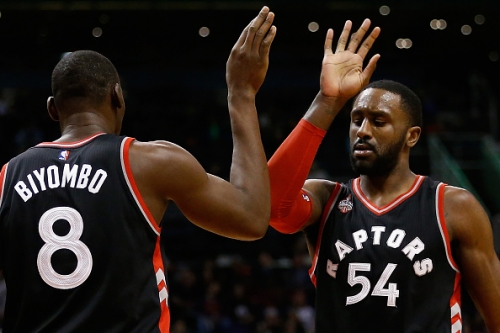The massive post-season looms large, waiting to pass judgement on the coach, the All-Stars, and the roster. The promise of spring brings with it the excitement of the unknown, hope is what some call it, while at the same time, old fears awaken. The season has been nothing but riding one high after the other, as the questions asked of the roster are answered with exclamation marks. With the purified air of the top seed in sight, the second place East ranking betrays the fact that it is Toronto that will be heading into the post-season playing the best basketball of the conference. The only uneasiness comes from the prospect of facing the experience-heavy Bulls, who would be no doubt targeting the Raptors in the rifle scope.
It is imperative to note that the approach play to this post-season has been vastly different than the last, and that is what should afford supporters of this club to take a more optimistic view of what lies ahead. For starters, the coach has finally taken the health of his players a tad bit more seriously. Last season’s glaring mismanagement of Kyle Lowry was a completely overlooked point in the post-mortem that followed the embarrassing sweep at the hands of the Wizards. Fans (along with this space) had implored Dwane Casey to heed the warning signs of Kyle Lowry being in the red for the entire post All-Star break period, and instead had seen their best player gimp around for 35 plus minutes down the stretch in games that simply weren’t important. The tactical rest that Lowry is receiving right now cannot be understated, with the latest evidence in support of the convalescence being DeMar DeRozan’s performance against the Celtics.
Facing the prospect of Jimmy Butler, Nicolas Batum, Paul George, or Joe Johnson, the Raptors have to feel well-primed after they shut down DeMarre Carroll, knowing full well that it was for these matchups that they made him the highest paid player on the roster. It was an example of better injury management, which was altogether missing last season. The main objective of the last dozen games has to be bedding in Carroll and ensuring he has the sufficient rhythm needed to make an impact. The fresh legs that he’ll have will help his aggressive style of play, and depending on matchup, could be the difference between winning or losing a round.
On a more tangible front, the scoring balance on the roster is far more likely to project into the playoffs than last season. The Raptors are relying immensely on Kyle Lowry and DeMar DeRozan, and this dependency is often seen as a negative. I don’t get this view, because this is true for everyone but one or two teams. A team’s top two players will dominate usage rates which aggregate between 45-50%, and the Raptors are no different. What’s more pertinent is thaDwane Casey has managed to concoct bench lineups that are able to produce a diverse blend of offense consistently with only one of Lowry and DeRozan playing alongside them. In sharp contrast, last season’s one-man bench of Lou Williams was a dish that was stale in February, dangerous in March, and downright toxic in April. Throw in a confident Jonas Valanciunas that is put in positions to have a bigger impact in the fourth quarter, with teammates actively looking for him, and it makes for a bulging offensive arsenal.
The Raptors have also seen spot contributions coming from players who play sporadic minutes. This is a testament to team and individual preparation, and Dwane Casey deserves credit for developing the luxury of calling on Norman Powell, James Johnson, Delon Wright, Jason Thompson, and Lucas Nogueira and getting productive minutes. The Raptors have showed a consistent trait of staying in games, and even in the reverse in Boston there was an element of a comeback as the team sans Lowry cut the lead down to one late in the game. Staying in close games elevates the importance of late-game management, and having tools at your disposal that can come in and make a key defensive stop, get a contested rebound, or hit that jumper are valuable. The readiness of the second and third tiers of players the Raptors have is far greater than the last two years, lending greater depth and options.
Toronto may boast the 5th ranked offense in the league (though they are closer to #18 than #1), yet it is their defense that the team has hung its hat on time and time again. The overall DRTG numbers don’t show that Cory Joseph, Bismack Biyombo, and Patrick Patterson have been the spine of many a unit that has held off opponents and closed out games. All three are second unit players that have come in and played a brand of defense that was altogether missing last season. Their shortcomings pale in comparison to the bench unit the Raptors entered the last two springs bearing.
Terrence Ross and Patrick Patterson have long been hailed as the two pieces that make up the tipping point of the team, and both are playing confident, productive basketball, especially on the defensive side. Though both hit valleys earlier in the year their form since December has been consistent to the point of being reliable, and that couldn’t have been said last March.
DeMar DeRozan and Kyle Lowry are the two heavy hitters in the lineup, but as we inspect the rest of the lineup, we’ll find improvements ranging from moderate to high which puts the Raptors in a far better position heading into a post-season that will be begging to render verdicts.
In short, there is nothing wrong with the Raptors that cannot be cured with what is right with the Raptors.




